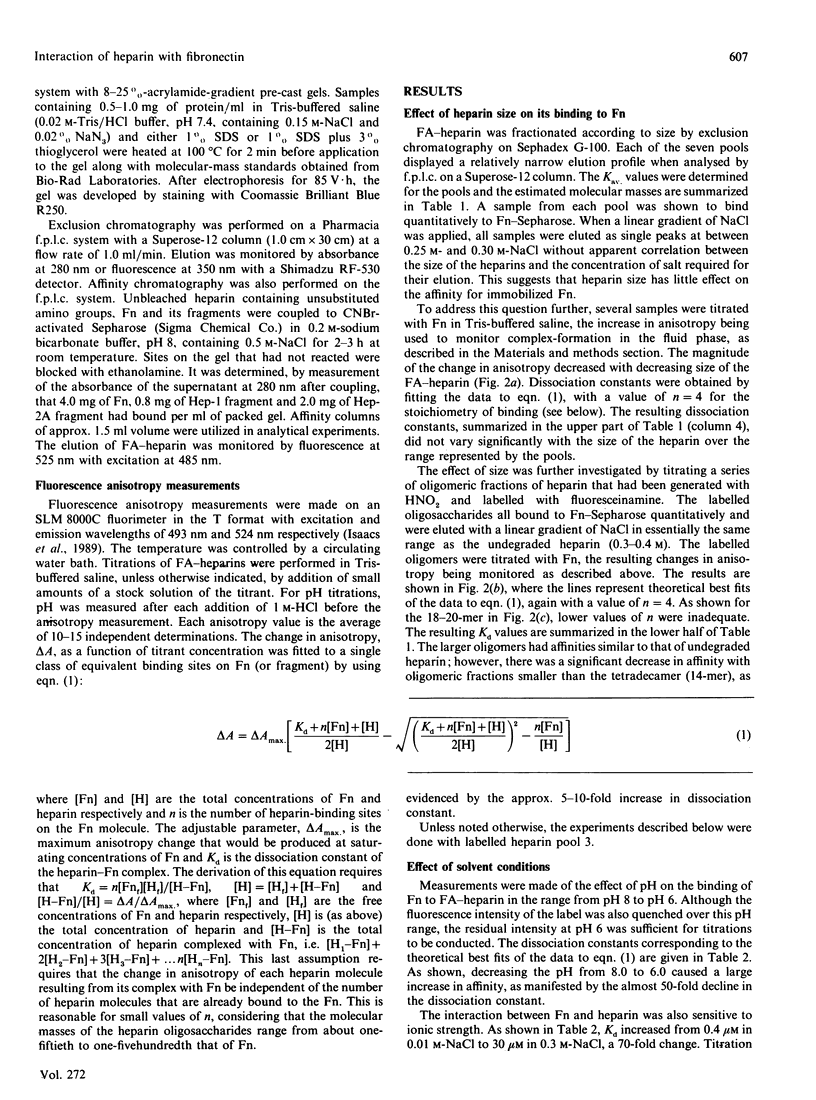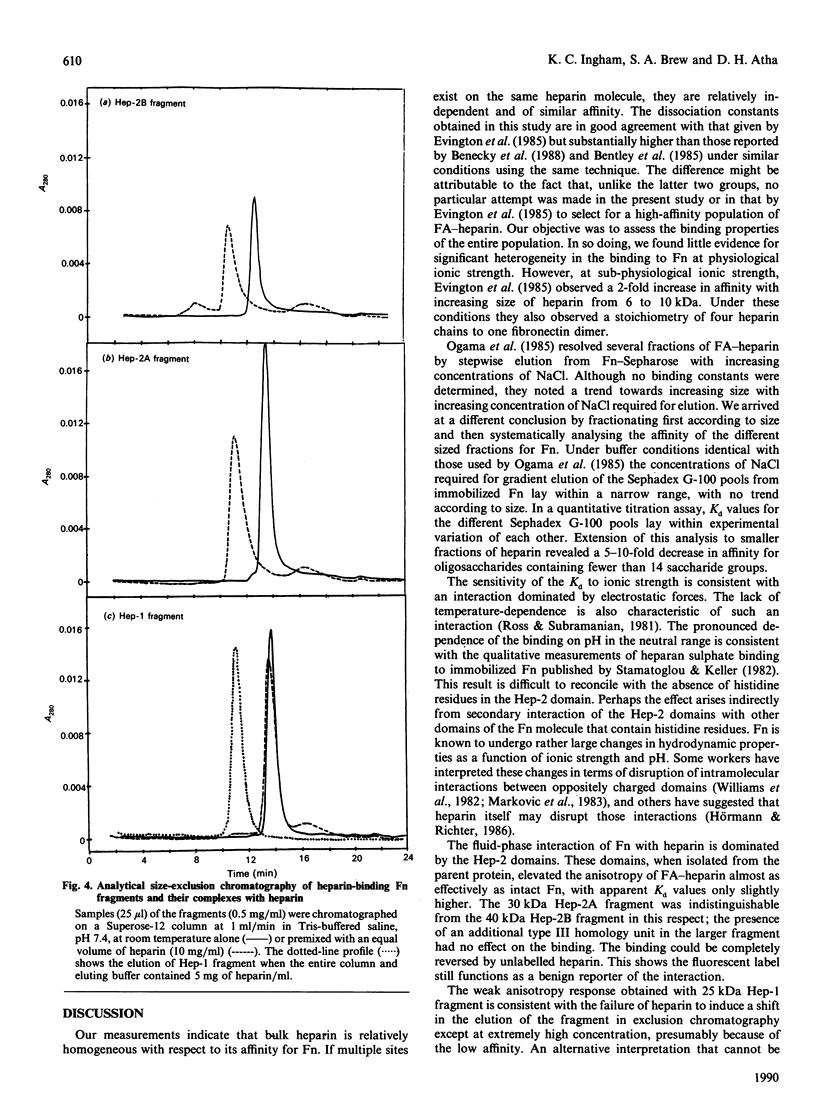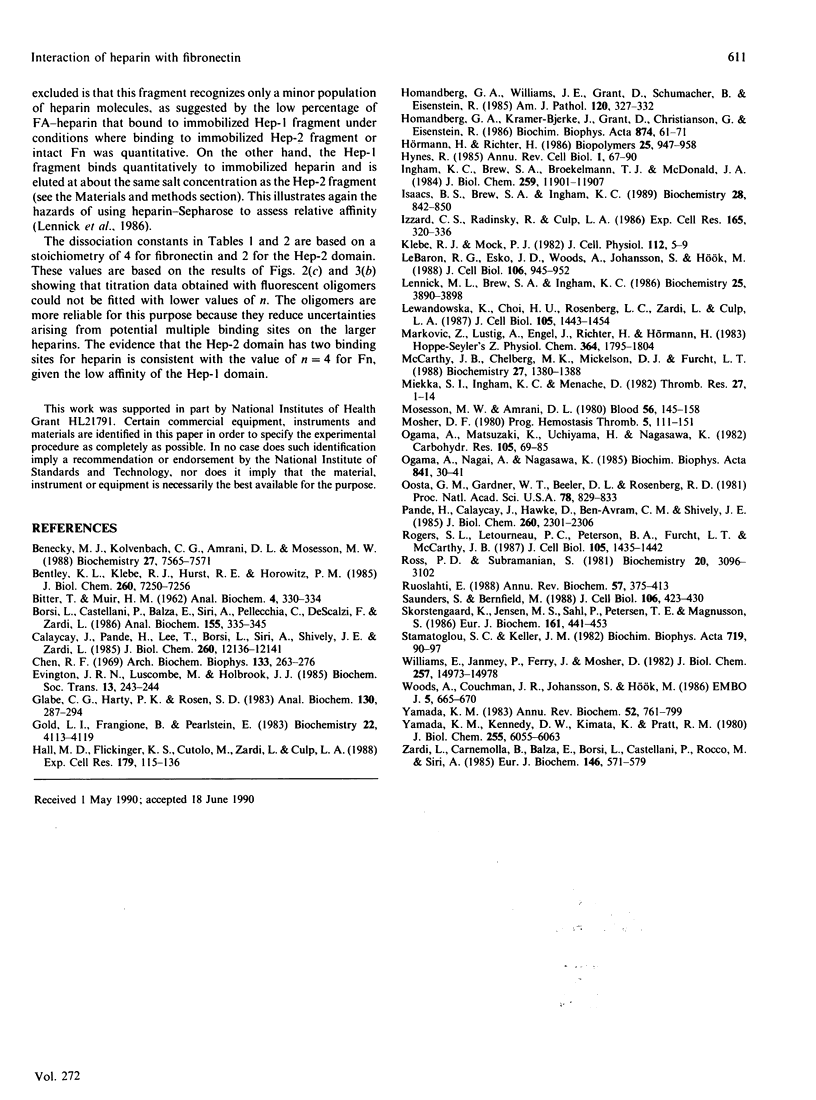Abstract
Fluorescence polarization, gel exclusion chromatography and affinity chromatography were used to characterize the interaction of heparins of different size with human plasma fibronectin (Fn) and several of its isolated domains. The fluid-phase interaction of Fn with heparin was dominated by the 30 kDa and 40 kDa Hep-2 domains located near the C-terminal ends of the A and B chains respectively. The 30 kDa Hep-2A domain from the heavy chain was indistinguishable from the 40 kDa Hep-2B domain in this respect; the presence of an additional type III homology unit in the latter had no effect on the binding. Evidence was provided that each Hep-2 domain has two binding sites for heparin. The N-terminal Hep-1 domain reacted weakly in fluid phase even though it binds strongly to immobilized heparin. Fn and Hep-2 fragments were rather undiscriminating in their reaction with fluoresceinamine-labelled heparins of different sizes. However, oligosaccharides smaller than the tetradecasaccharide (14-mer) bound Fn with a 5-10-fold lower affinity. These results suggest that the Hep-2 domains of Fn are able to recognize a broad spectrum of oligosaccharides that presumably vary significantly with respect to the amount and spatial distribution of charge.
Full text
PDF






Images in this article
Selected References
These references are in PubMed. This may not be the complete list of references from this article.
- BITTER T., MUIR H. M. A modified uronic acid carbazole reaction. Anal Biochem. 1962 Oct;4:330–334. doi: 10.1016/0003-2697(62)90095-7. [DOI] [PubMed] [Google Scholar]
- Benecky M. J., Kolvenbach C. G., Amrani D. L., Mosesson M. W. Evidence that binding to the carboxyl-terminal heparin-binding domain (Hep II) dominates the interaction between plasma fibronectin and heparin. Biochemistry. 1988 Sep 20;27(19):7565–7571. doi: 10.1021/bi00419a058. [DOI] [PubMed] [Google Scholar]
- Bentley K. L., Klebe R. J., Hurst R. E., Horowitz P. M. Heparin binding is necessary, but not sufficient, for fibronectin aggregation. A fluorescence polarization study. J Biol Chem. 1985 Jun 25;260(12):7250–7256. [PubMed] [Google Scholar]
- Borsi L., Castellani P., Balza E., Siri A., Pellecchia C., De Scalzi F., Zardi L. Large-scale procedure for the purification of fibronectin domains. Anal Biochem. 1986 Jun;155(2):335–345. doi: 10.1016/0003-2697(86)90443-4. [DOI] [PubMed] [Google Scholar]
- Calaycay J., Pande H., Lee T., Borsi L., Siri A., Shively J. E., Zardi L. Primary structure of a DNA- and heparin-binding domain (Domain III) in human plasma fibronectin. J Biol Chem. 1985 Oct 5;260(22):12136–12141. [PubMed] [Google Scholar]
- Chen R. F. Fluorescent protein-dye conjugates. II. Gamma globulin conjugated with various dyes. Arch Biochem Biophys. 1969 Sep;133(2):263–276. doi: 10.1016/0003-9861(69)90454-8. [DOI] [PubMed] [Google Scholar]
- Glabe C. G., Harty P. K., Rosen S. D. Preparation and properties of fluorescent polysaccharides. Anal Biochem. 1983 Apr 15;130(2):287–294. doi: 10.1016/0003-2697(83)90590-0. [DOI] [PubMed] [Google Scholar]
- Gold L. I., Frangione B., Pearlstein E. Biochemical and immunological characterization of three binding sites on human plasma fibronectin with different affinities for heparin. Biochemistry. 1983 Aug 16;22(17):4113–4119. doi: 10.1021/bi00286a019. [DOI] [PubMed] [Google Scholar]
- Hall M. D., Flickinger K. S., Cutolo M., Zardi L., Culp L. A. Adhesion of human dermal reticular fibroblasts on complementary fragments of fibronectin: aging in vivo or in vitro. Exp Cell Res. 1988 Nov;179(1):115–136. doi: 10.1016/0014-4827(88)90353-9. [DOI] [PubMed] [Google Scholar]
- Homandberg G. A., Kramer-Bjerke J., Grant D., Christianson G., Eisenstein R. Heparin-binding fragments of fibronectin are potent inhibitors of endothelial cell growth: structure-function correlations. Biochim Biophys Acta. 1986 Nov 7;874(1):61–71. doi: 10.1016/0167-4838(86)90102-0. [DOI] [PubMed] [Google Scholar]
- Homandberg G. A., Williams J. E., Grant D., Schumacher B., Eisenstein R. Heparin-binding fragments of fibronectin are potent inhibitors of endothelial cell growth. Am J Pathol. 1985 Sep;120(3):327–332. [PMC free article] [PubMed] [Google Scholar]
- Hynes R. Molecular biology of fibronectin. Annu Rev Cell Biol. 1985;1:67–90. doi: 10.1146/annurev.cb.01.110185.000435. [DOI] [PubMed] [Google Scholar]
- Hörmann H., Richter H. Models for the subunit arrangement in soluble and aggregated plasma fibronectin. Biopolymers. 1986 May;25(5):947–958. doi: 10.1002/bip.360250513. [DOI] [PubMed] [Google Scholar]
- Ingham K. C., Brew S. A., Broekelmann T. J., McDonald J. A. Thermal stability of human plasma fibronectin and its constituent domains. J Biol Chem. 1984 Oct 10;259(19):11901–11907. [PubMed] [Google Scholar]
- Isaacs B. S., Brew S. A., Ingham K. C. Reversible unfolding of the gelatin-binding domain of fibronectin: structural stability in relation to function. Biochemistry. 1989 Jan 24;28(2):842–850. doi: 10.1021/bi00428a065. [DOI] [PubMed] [Google Scholar]
- Izzard C. S., Radinsky R., Culp L. A. Substratum contacts and cytoskeletal reorganization of BALB/c 3T3 cells on a cell-binding fragment and heparin-binding fragments of plasma fibronectin. Exp Cell Res. 1986 Aug;165(2):320–336. doi: 10.1016/0014-4827(86)90586-0. [DOI] [PubMed] [Google Scholar]
- Klebe R. J., Mock P. J. Effect of glycosaminoglycans on fibronectin-mediated cell attachment. J Cell Physiol. 1982 Jul;112(1):5–9. doi: 10.1002/jcp.1041120103. [DOI] [PubMed] [Google Scholar]
- LeBaron R. G., Esko J. D., Woods A., Johansson S., Hök M. Adhesion of glycosaminoglycan-deficient chinese hamster ovary cell mutants to fibronectin substrata. J Cell Biol. 1988 Mar;106(3):945–952. doi: 10.1083/jcb.106.3.945. [DOI] [PMC free article] [PubMed] [Google Scholar]
- Lennick M., Brew S. A., Ingham K. C. Kinetics of interaction of C1 inhibitor with complement C1s. Biochemistry. 1986 Jul 1;25(13):3890–3898. doi: 10.1021/bi00361a023. [DOI] [PubMed] [Google Scholar]
- Lewandowska K., Choi H. U., Rosenberg L. C., Zardi L., Culp L. A. Fibronectin-mediated adhesion of fibroblasts: inhibition by dermatan sulfate proteoglycan and evidence for a cryptic glycosaminoglycan-binding domain. J Cell Biol. 1987 Sep;105(3):1443–1454. doi: 10.1083/jcb.105.3.1443. [DOI] [PMC free article] [PubMed] [Google Scholar]
- Marković Z., Lustig A., Engel J., Richter H., Hörmann H. Shape and stability of fibronectin in solutions of different pH and ionic strength. Hoppe Seylers Z Physiol Chem. 1983 Dec;364(12):1795–1804. doi: 10.1515/bchm2.1983.364.2.1795. [DOI] [PubMed] [Google Scholar]
- McCarthy J. B., Chelberg M. K., Mickelson D. J., Furcht L. T. Localization and chemical synthesis of fibronectin peptides with melanoma adhesion and heparin binding activities. Biochemistry. 1988 Feb 23;27(4):1380–1388. doi: 10.1021/bi00404a044. [DOI] [PubMed] [Google Scholar]
- Miekka S. I., Ingham K. C., Menache D. Rapid methods for isolation of human plasma fibronectin. Thromb Res. 1982 Jul 1;27(1):1–14. doi: 10.1016/0049-3848(82)90272-9. [DOI] [PubMed] [Google Scholar]
- Mosesson M. W., Amrani D. L. The structure and biologic activities of plasma fibronectin. Blood. 1980 Aug;56(2):145–158. [PubMed] [Google Scholar]
- Mosher D. F. Fibronectin. Prog Hemost Thromb. 1980;5:111–151. [PubMed] [Google Scholar]
- Ogamo A., Matsuzaki K., Uchiyama H., Nagasawa K. Preparation and properties of fluorescent glycosaminoglycuronans labeled with 5-aminofluorescein. Carbohydr Res. 1982 Jul 1;105(1):69–85. doi: 10.1016/s0008-6215(00)81855-8. [DOI] [PubMed] [Google Scholar]
- Ogamo A., Nagai A., Nagasawa K. Binding of heparin fractions and other polysulfated polysaccharides to plasma fibronectin: effects of molecular size and degree of sulfation of polysaccharides. Biochim Biophys Acta. 1985 Jul 26;841(1):30–41. [PubMed] [Google Scholar]
- Oosta G. M., Gardner W. T., Beeler D. L., Rosenberg R. D. Multiple functional domains of the heparin molecule. Proc Natl Acad Sci U S A. 1981 Feb;78(2):829–833. doi: 10.1073/pnas.78.2.829. [DOI] [PMC free article] [PubMed] [Google Scholar]
- Pande H., Calaycay J., Hawke D., Ben-Avram C. M., Shively J. E. Primary structure of a glycosylated DNA-binding domain in human plasma fibronectin. J Biol Chem. 1985 Feb 25;260(4):2301–2306. [PubMed] [Google Scholar]
- Rogers S. L., Letourneau P. C., Peterson B. A., Furcht L. T., McCarthy J. B. Selective interaction of peripheral and central nervous system cells with two distinct cell-binding domains of fibronectin. J Cell Biol. 1987 Sep;105(3):1435–1442. doi: 10.1083/jcb.105.3.1435. [DOI] [PMC free article] [PubMed] [Google Scholar]
- Ross P. D., Subramanian S. Thermodynamics of protein association reactions: forces contributing to stability. Biochemistry. 1981 May 26;20(11):3096–3102. doi: 10.1021/bi00514a017. [DOI] [PubMed] [Google Scholar]
- Ruoslahti E. Fibronectin and its receptors. Annu Rev Biochem. 1988;57:375–413. doi: 10.1146/annurev.bi.57.070188.002111. [DOI] [PubMed] [Google Scholar]
- Saunders S., Bernfield M. Cell surface proteoglycan binds mouse mammary epithelial cells to fibronectin and behaves as a receptor for interstitial matrix. J Cell Biol. 1988 Feb;106(2):423–430. doi: 10.1083/jcb.106.2.423. [DOI] [PMC free article] [PubMed] [Google Scholar]
- Skorstengaard K., Jensen M. S., Sahl P., Petersen T. E., Magnusson S. Complete primary structure of bovine plasma fibronectin. Eur J Biochem. 1986 Dec 1;161(2):441–453. doi: 10.1111/j.1432-1033.1986.tb10464.x. [DOI] [PubMed] [Google Scholar]
- Stamatoglou S. C., Keller J. M. Interactions of cellular glycosaminoglycans with plasma fibronectin and collagen. Biochim Biophys Acta. 1982 Oct 28;719(1):90–97. doi: 10.1016/0304-4165(82)90311-7. [DOI] [PubMed] [Google Scholar]
- Williams E. C., Janmey P. A., Ferry J. D., Mosher D. F. Conformational states of fibronectin. Effects of pH, ionic strength, and collagen binding. J Biol Chem. 1982 Dec 25;257(24):14973–14978. [PubMed] [Google Scholar]
- Woods A., Couchman J. R., Johansson S., Hök M. Adhesion and cytoskeletal organisation of fibroblasts in response to fibronectin fragments. EMBO J. 1986 Apr;5(4):665–670. doi: 10.1002/j.1460-2075.1986.tb04265.x. [DOI] [PMC free article] [PubMed] [Google Scholar]
- Yamada K. M. Cell surface interactions with extracellular materials. Annu Rev Biochem. 1983;52:761–799. doi: 10.1146/annurev.bi.52.070183.003553. [DOI] [PubMed] [Google Scholar]
- Yamada K. M., Kennedy D. W., Kimata K., Pratt R. M. Characterization of fibronectin interactions with glycosaminoglycans and identification of active proteolytic fragments. J Biol Chem. 1980 Jul 10;255(13):6055–6063. [PubMed] [Google Scholar]
- Zardi L., Carnemolla B., Balza E., Borsi L., Castellani P., Rocco M., Siri A. Elution of fibronectin proteolytic fragments from a hydroxyapatite chromatography column. A simple procedure for the purification of fibronectin domains. Eur J Biochem. 1985 Feb 1;146(3):571–579. doi: 10.1111/j.1432-1033.1985.tb08690.x. [DOI] [PubMed] [Google Scholar]



